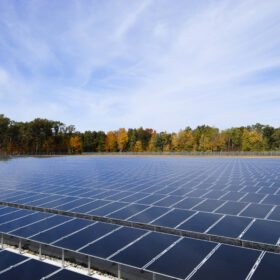Reflecting the reality that it has become incredibly popular for companies to add renewable energy resourcing as part of their various environmental impact policies, Duke Energy has proposed a program to the Public Service Commission of South Carolina (PSC) which would allow large commercial and industrial (C&I) customers to purchase energy and the renewable energy credits (RECs) that come with it from the various renewable energy projects located throughout the state.
If approved, the Green Source Advantage (GSC) program would allocate the output of 150 MW of mostly solar renewable generation from Duke’s various projects in the Palmetto state to nonresidential customers of Duke Energy Carolinas and Duke Energy Progress. GSC’s 150 MW pool would be divided among the two utilities, with 113 MW of capacity reserved for customers of Duke Energy Carolinas and the remaining 37 MW divvied out to participating C&I customers of Duke Energy Progress.
The program is structured similarly to many community solar programs. For the customers, potential benefits are twofold. It allows companies to meet their increasingly common renewable energy resourcing goals without having to front the capital needed to install a solar system on their property, while also reducing the cost of their monthly energy bill via the renewable energy certificates (RECs) produced by the facility.
“We’ve received significant interest from our large commercial and industrial customers in offering programs that help them meet their sustainability goals,” said Duke Energy’s South Carolina president Kodwo Ghartey-Tagoe in a release touting the program’s submission to PSC. “The Green Source Advantage program will leverage renewable energy options to do just that.”
Duke credits GSA, as well as almost all of its other programs in South Carolina as being possible as a result of the passage of South Carolina’s Act 236. Passed in 2014, Act 236 opened the floodgates for solar development of all kinds in South Carolina, from residential systems to multi-MW utility-grade solar farms. And, while the Act accomplished the SC solar boom through policies like net metering and solar rebate offerings, it’s the same one that has somewhat plateaued residential installation numbers because of its caps on the state’s net metering program at 2% of peak capacity.
Even with the net metering caps, solar in South Carolina is still strong, but not nearly on the meteoric climb that it was just a year ago. The state ranks 18th in total installed solar capacity, according to SEIA, but that alone is 10 spots below the state’s 8th-place mark in 2017. South Carolina also exists in the solar shadow of it’s sister state, which is ranked 2nd by installed capacity.
North Carolina boasts a total installed capacity of over 4,490 MW, and is projected to add 4,230 MW over the next five years, which SEIA projects to be the 4th-highest capacity of any state in that timeframe. South Carolina has a total installed capacity of just over 590 MW, and SEIA projects only 907 MW in the five-year timeframe, just 20th in the country for that projected span.
Duke is hopeful that the program will continue South Carolina to be “one of the country’s greatest success stories for renewable energy.” And, while the recent hiccup in development in that state is troubling, a shared solar program for C&I customers could prove to be the jumpstart the state needed. Just look at Minnesota. Minnesota’s community solar program is the most successful in the country and 90% of its total installed capacity comes from nonresidential customers.
This content is protected by copyright and may not be reused. If you want to cooperate with us and would like to reuse some of our content, please contact: editors@pv-magazine.com.









Lets stop providing these tricks to make people feel good and just put
the total on the grid and reduce everybodys cost.
Thanks , Ken